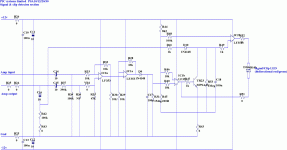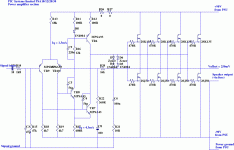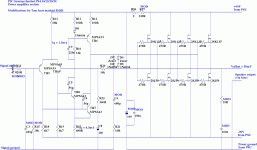Now, here's a minority interest story...
A couple of weeks ago I decided to overhaul my big PSL amplifier. These simple MOSFET amplifiers where manufactured by PIC Systems in Bristol, England, during the 90s. The company seems to have sunk without trace. Mine is one of their earlier models; years of abuse on the road have rendered the rating place illegable, but the model is either a PSA10, 12, 20 or 30. The year of manufacture is possibly 1992 and the power output rather optimistically stated as 500W/ch.
Having been gigged heavily for years, and then sat in a damp shed for some more years, the main intention was to give it a good clean and remove any corrosion. I also re-worked a lot of the solder; since these amps run hotter than the sun, several of the power devices had come close to unsoldering themselves. I also reversed the physical orientation of the fans (reversing the power to a brushless DC fan, of course, achieves nothing) since it originally vented back-to-front which, in my mind at least, is wrong (and is also different to their later models).
While I had the lid off, I thought it might be instructive to trace the circuit. Since the amplifier propper consists of only five transistors, this was within the bounds of even my limited attention span. Nearly. As it turns out, I've only bothered to transscribe the amplifier and LED driver sections; the preamplifier and DC protection circuit (yes, it has one!) will have to remain a mystery. I'll apologise now for drafting the schematics in LTspice - it's not my favourate for making nice schematics, but it is the fastest.
The amplifier had been entirely functional before I started pulling it apart, but when I tested after re-assembly, I descoverd a nasty. Under load, both channels showed significant instability on positive signals greater than a couple of volts. It's possible that this fault has developed over time due to drifiting beta or other component values, but it is also possible that it has always been there - it's not the kind of problem which would be at all obvious in a multi-killowatt PA system kicking out 110dB SPL at several percent THD. I've certainly heard that FETs are more prone to parasisic oscillations than BJTs; is anyone aware of a parameter drift that might make this more likely over time? The DC offset was also quite shameful, at 0.25V.
The instability seemed to originate around TR6, the current "mirror" at the top of the ballanced VAS. To cut to the chase, I made some modifications to make it go away.
Suspecting feedback through the +90V line, I gave this some heavy R-C filtering - since the driver stage draws only a few mA, the R was quite big (330R) and the C was as big as I could find (100u). I'm curious as to whether this might improve the THD too... The Zobel network originally returned to the signal ground in the driver stage, then along the signal input lead screen back to the PSU. This seemed like a bad idea, so I moved it so that it could return to the power ground - that is, be conected directly accross the speaker output. That nearly did the trick, but an extra "small" Zobell with 680p, returned to the original signal ground, was needed to get the thing stable. I don't pretend to be any expert in the black arts of stability and grounding.
The poor showing in output offset turned out to be due mostly to the base current of TR9 dropping volts across R15. To improve matters, I've simply reduced the impedance of this entire network (reducing the Rs and increasing the Cs to match). In truth, I suspect I could simply have shorted the input coupling capacator C7, but was dubious of doing so in case it had actually been put there for a good reason. In any case, the offset is now about 50mV, which seems more acceptible.
I'd post some pictures, but I'm too cheap to buy a digital camera (send an SAE and I'll post you a Polaroid). By way of substitute though, I'll attach the schematcs for the amp and the (far more complicated) circuit that drives the signal LED. The GIFs are awful, I know.
There are still a few of these beasts out there, so who knows, it may even be useful. I doubt that their other amps where much different in design...
Enjoy!
A couple of weeks ago I decided to overhaul my big PSL amplifier. These simple MOSFET amplifiers where manufactured by PIC Systems in Bristol, England, during the 90s. The company seems to have sunk without trace. Mine is one of their earlier models; years of abuse on the road have rendered the rating place illegable, but the model is either a PSA10, 12, 20 or 30. The year of manufacture is possibly 1992 and the power output rather optimistically stated as 500W/ch.
Having been gigged heavily for years, and then sat in a damp shed for some more years, the main intention was to give it a good clean and remove any corrosion. I also re-worked a lot of the solder; since these amps run hotter than the sun, several of the power devices had come close to unsoldering themselves. I also reversed the physical orientation of the fans (reversing the power to a brushless DC fan, of course, achieves nothing) since it originally vented back-to-front which, in my mind at least, is wrong (and is also different to their later models).
While I had the lid off, I thought it might be instructive to trace the circuit. Since the amplifier propper consists of only five transistors, this was within the bounds of even my limited attention span. Nearly. As it turns out, I've only bothered to transscribe the amplifier and LED driver sections; the preamplifier and DC protection circuit (yes, it has one!) will have to remain a mystery. I'll apologise now for drafting the schematics in LTspice - it's not my favourate for making nice schematics, but it is the fastest.
The amplifier had been entirely functional before I started pulling it apart, but when I tested after re-assembly, I descoverd a nasty. Under load, both channels showed significant instability on positive signals greater than a couple of volts. It's possible that this fault has developed over time due to drifiting beta or other component values, but it is also possible that it has always been there - it's not the kind of problem which would be at all obvious in a multi-killowatt PA system kicking out 110dB SPL at several percent THD. I've certainly heard that FETs are more prone to parasisic oscillations than BJTs; is anyone aware of a parameter drift that might make this more likely over time? The DC offset was also quite shameful, at 0.25V.
The instability seemed to originate around TR6, the current "mirror" at the top of the ballanced VAS. To cut to the chase, I made some modifications to make it go away.
Suspecting feedback through the +90V line, I gave this some heavy R-C filtering - since the driver stage draws only a few mA, the R was quite big (330R) and the C was as big as I could find (100u). I'm curious as to whether this might improve the THD too... The Zobel network originally returned to the signal ground in the driver stage, then along the signal input lead screen back to the PSU. This seemed like a bad idea, so I moved it so that it could return to the power ground - that is, be conected directly accross the speaker output. That nearly did the trick, but an extra "small" Zobell with 680p, returned to the original signal ground, was needed to get the thing stable. I don't pretend to be any expert in the black arts of stability and grounding.
The poor showing in output offset turned out to be due mostly to the base current of TR9 dropping volts across R15. To improve matters, I've simply reduced the impedance of this entire network (reducing the Rs and increasing the Cs to match). In truth, I suspect I could simply have shorted the input coupling capacator C7, but was dubious of doing so in case it had actually been put there for a good reason. In any case, the offset is now about 50mV, which seems more acceptible.
I'd post some pictures, but I'm too cheap to buy a digital camera (send an SAE and I'll post you a Polaroid). By way of substitute though, I'll attach the schematcs for the amp and the (far more complicated) circuit that drives the signal LED. The GIFs are awful, I know.
There are still a few of these beasts out there, so who knows, it may even be useful. I doubt that their other amps where much different in design...
Enjoy!
Attachments
Last edited:
- Status
- Not open for further replies.


